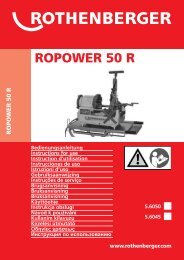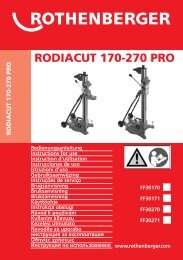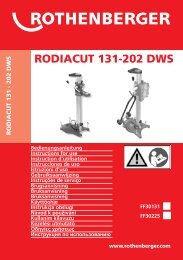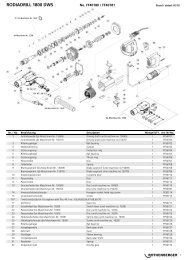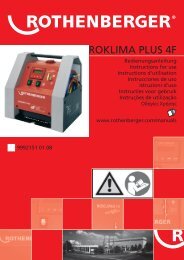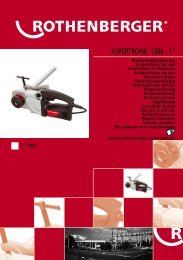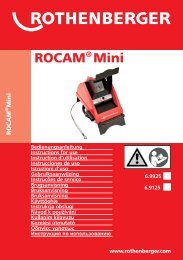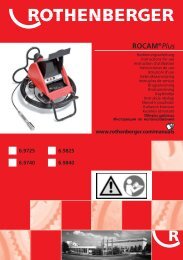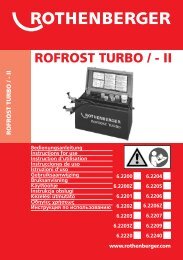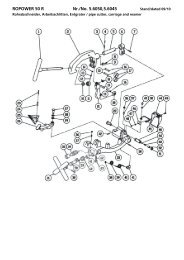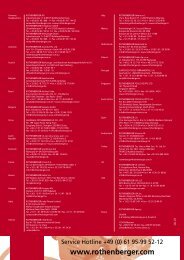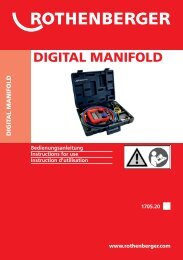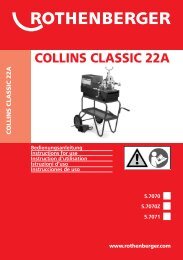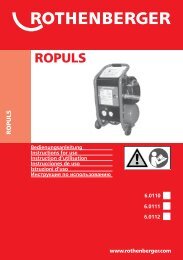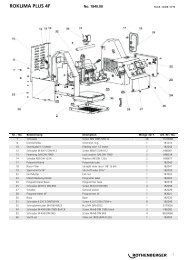Care and maintenance Operation G H 1 2 4 - Rothenberger
Care and maintenance Operation G H 1 2 4 - Rothenberger
Care and maintenance Operation G H 1 2 4 - Rothenberger
You also want an ePaper? Increase the reach of your titles
YUMPU automatically turns print PDFs into web optimized ePapers that Google loves.
General safety rules<br />
WARNING! Read all instructions. Failure<br />
to follow all instructions listed below may<br />
result in electric shock, fire <strong>and</strong>/or serious<br />
injury. The term "power tool" in all of the<br />
warnings listed below refers to your mains<br />
operated (corded) power tool or battery operated<br />
(cordless) power tool.<br />
SAVE THESE INSTRUCTIONS.<br />
1) Work area<br />
a) Keep work area clean <strong>and</strong> well lit.<br />
Cluttered <strong>and</strong> dark areas invite accidents.<br />
b) Do not operate power tools in explosive<br />
atmospheres, such as in the presence of<br />
flammable liquids, gases or dust. Power<br />
tools create sparks which may ignite the dust<br />
or fumes.<br />
c) Keep children <strong>and</strong> byst<strong>and</strong>ers away while<br />
operating a power tool. Distractions can<br />
cause you to lose control.<br />
2) Electrical safety<br />
a) Power tool plugs must match the outlet.<br />
Never modify the plug in any way. Do not<br />
use any adapter plugs with earthed<br />
(grounded) power tools. Unmodified plugs<br />
<strong>and</strong> matching outlets will reduce risk of electric<br />
shock.<br />
b) Avoid body contact with earthed or<br />
grounded surfaces such as pipes,<br />
radiators, ranges <strong>and</strong> refrigerators. There is<br />
an increased risk of electric shock if your body<br />
is earthed or grounded.<br />
c) Do not expose power tools to rain or wet<br />
conditions. Water entering a power tool will<br />
increase the risk of electric shock.<br />
d) Do not abuse the cord. Never use the cord<br />
for carrying, pulling or unplugging the<br />
power tool. Keep cord away from heat,<br />
oil, sharp edges or moving parts. Damaged<br />
or entangled cords increase the risk of electric<br />
shock.<br />
e) When operating a power tool outdoors,<br />
use an extension cord suitable for outdoor<br />
use. Use of a cord suitable for outdoor use<br />
reduces the risk of electric shock.<br />
3) Personal safety<br />
a) Stay alert, watch what you are doing <strong>and</strong><br />
use common sense when operating a<br />
power tool. Do not use a power tool while<br />
you are tired or under the influence of<br />
drugs, alcohol or medication. A moment of<br />
in attention while operating power tools may<br />
result in serious personal injury.<br />
b) Use safety equipment. Always wear eye<br />
protection. Safety equipment such as dust<br />
mask, nonskid safety shoes, hard hat, or<br />
hearing protection used for appropriate<br />
conditions will reduce personal injuries.<br />
c) Avoid accidental starting. Ensure the<br />
switch is in the off position before<br />
plugging in. Carrying power tools with your<br />
finger on the switch or plugging in power tools<br />
that have the switch on invites accidents.<br />
d) Remove any adjusting key or wrench<br />
before turning the power tool on. A<br />
wrench or a key left attached to a rotating part<br />
of the power tool may result in personal injury.<br />
e) Do not overreach. Keep proper footing<br />
<strong>and</strong> balance at all times. This enables better<br />
control of the power tool in unexpected<br />
situations.<br />
f) Dress properly. Do not wear loose clothing<br />
or jewellery. Keep your hair, clothing <strong>and</strong><br />
gloves away rom moving parts. Loose<br />
clothes, jewellery or long hair can be caught in<br />
moving parts.<br />
g) If devices are provided for the connection<br />
of dust extraction <strong>and</strong> collection facilities,<br />
ensure these are connected <strong>and</strong> properly<br />
used. Use of these devices can reduce dust<br />
related hazards.<br />
4) Power tool use <strong>and</strong> care<br />
a) Do not force the power tool. Use the<br />
correct power tool for your application.<br />
The correct power tool will do the job better<br />
<strong>and</strong> safer at the rate for which it was designed.<br />
b) Do not use the power tool if the switch<br />
does not turn it on <strong>and</strong> off. Any power tool<br />
that cannot be controlled with the switch is<br />
dangerous <strong>and</strong> must be repaired.<br />
c) Disconnect the plug from the power<br />
source before making any adjustments,<br />
changing accessories, or storing power<br />
tools. Such preventive safety measures reduce<br />
the risk of starting the power tool accidentally.<br />
d) Store idle power tools out of the reach of<br />
children <strong>and</strong> do not allow persons<br />
unfamiliar with the power tool or these<br />
instructions to operate the power tool.<br />
Power tools are dangerous in the h<strong>and</strong>s of<br />
untrained users.<br />
e) Maintain power tools. Check for<br />
misalignment or binding of moving parts,<br />
breakage of parts <strong>and</strong> any other condition<br />
ENGLISH 7



